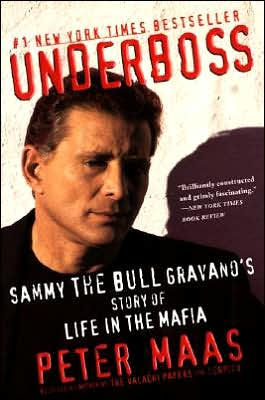Read an Excerpt
Chapter OneThey're bad people, but they're our bad people.
"Yeah, you could say i came from a pretty tough neighborhood," Salvatore (Sammy the Bull) Gravano said.
The neighborhood was Bensonhurst, roughly two miles square, in southwestern Brooklyn bordering Gravesend Bay and the Atlantic Ocean.
Unlike the first Italian communities in New York, such as Manhattan's Little Italy, which was being swallowed up by an aggressively expanding Chinatown, or East Harlem, clinging to a narrow strip along the East River against the inroads of a booming Hispanic population, Bensonhurst remained vibrantly and definitively Italian-American. Even today it is where recent arrivals from southern Italy and Sicily settle. In Roman Catholic churches, some masses are sung in Italian.
As with other ethnic migrations in the city, the subway paved the way when in the early 1900s the first rapid transit lines linking Brooklyn to Manhattan went into service, one of them going directly from the dark and crowded tenements of Little Italy to the open spaces of Bensonhurst.
It has a small-town feel. Many of the cross streets lack traffic lights. Cruising taxis, common in most of the city, are rare. Houses are mostly two-family dwellings of aluminum siding, stucco or brick with wrought-iron gates painted white and porches with their ubiquitous steel awnings. Tiny front lawns feature potted flowers and statues of the Virgin Mary and in backyards, more often than not, are vegetable gardens. Bensonhurst's main street, 18th Avenue, also officially designated Cristoforo Colombo Boulevard, is lined with Italian delicatessens, bakeries, fresh mozzarella shops, food marketsoverflowing with packaged products imported from Italy, pizza parlors boasting traditional wood-burning ovens and espresso bars.
In Bensonhurst, everyone knows everyone else on every block. Its mainly blue-collar residents are insular, closemouthed and suspicious of outsiders. Strangers are remarked on at once. As a result, the rate of common street crimes--rapes, robberies, felony assaults--is low compared to other parts of the city, according to police statistics. Murder is a third less than the citywide average.
But Bensonhurst was tough in a very special sense. A great number of these murders were mob related. It was a prime spawning ground for Cosa Nostra--"Our Thing"--which filled its ranks from local youth street gangs that hung out at candy stores and luncheonettes throughout the area. One of the original members of Cosa Nostra's national commission, Joseph Profaci, the so-called Olive Oil King because of his monopoly on the importation of olive oil from Italy, lived in Bensonhurst. So did his successor as a family boss, Joseph Colombo. One of the grandest underworld funerals ever seen in New York, complete with thirty-eight carloads of flowers, took place in Bensonhurst following the Prohibition-era slaying of a celebrated mobster named Frankie Yale, who had a falling out with Al Capone.
As in a Sicilian village, Cosa Nostra's shadow loomed large over Bensonhurst and was spoken of only in whispers. "They just shoot themselves," a resident confided after two corpses were found in a car, gazing vacantly into space, each with a bullet hole behind the ear. "The thing is, you mind your own business. You don't hear nothing. You don't see nothing." Another said, "You got to admit the Mafia, whatever, keeps the neighborhood safe. You don't see all them other people coming in to mug and burglarize here. So their presence is kind of good is my opinion."
Salvatore Gravano was born in Bensonhurst on March 12, 1945. He had two older sisters. Another sister and a brother had died before his arrival. His mother, Caterina, was born in Sicily and brought to America as a baby. His father, Giorlando, also from Sicily, was on the crew of a freighter when he jumped ship in Canada and slipped into the United States as an illegal alien.
For Sammy and for friends and neighbors, his parents were always Kay and Gerry. English was the language of the house, except during visits from his grandmothers, who spoke a Sicilian dialect. Sammy was especially close to his maternal grandmother and picked up enough to be able to converse with her, but forgot it all after she died.
He was called Sammy instead of Salvatore or Sal for as long as he can remember. Someone had said that he looked just like Uncle Sammy, a brother of his mother's, and the name stuck. The uncle was Big Sammy and he was Little Sammy. He grew up on 78th Street in the heart of Bensonhurst near 18th Avenue. His father owned the house, the middle one of three identical brick row houses, each with a garage. Steps led up to the front porch. The basement apartment was rented out, as well as an apartment on the second floor. The Gravanos lived in the middle apartment. In a small plot behind the house, Sammy's father cultivated tomatoes and beans and tended to his prized fig tree.
Kay was an exceptionally skilled seamstress who worked for a Jewish dress manufacturer in Manhattan's garment center. Gerry was a house painter until he was felled by lead poisoning and could no longer continue his trade. The dress manufacturer then financed the Gravanos in a satellite factory of their own in Bensonhurst. Kay supervised the filling of the orders he sent her and rode the subway to the garment center to sew the sample dress for a forthcoming line, while Sammy's father took care of the business end. Things went so well that Gerry was able to afford the purchase of a summer cottage for $8,000 near Lake Ronkonkoma in the middle of Long Island.



